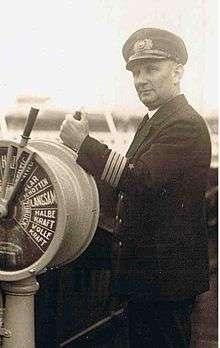SS Adolph Woermann
 SS Adolph Woermann | |
| History | |
|---|---|
| Name: | Adolph Woermann |
| Port of registry: | |
| Route: | for WL (Woermann Linie) and DOAL (German East Africa Line): Hamburg — Africa |
| Builder: | Blohm + Voss |
| Yard number: | 395 |
| Launched: | 1922 |
| Maiden voyage: | 15 November 1922 |
| Out of service: | 22 November 1939 |
| Fate: | scuttled |
| General characteristics | |
| Class and type: | ocean liner |
| Tonnage: | 8576 BRT |
| Displacement: | 4,944 NRT |
| Length: | 138.8 metres (455 ft) |
| Beam: | 17.7 metres (58 ft) |
| Installed power: | 1 Blohm + Voss steam turbine, 3300 PSw |
| Speed: | 12 knots (22 km/h; 14 mph) |
| Capacity: |
|
SS Adolph Woermann was a German ocean liner built in 1922 by Blohm + Voss in Hamburg, for the shipping lines Woermann-Linie (WL) and German East Africa Line (Deutsche Ostafrika Linie, DOAL) and named after German merchant, ship owner and politician Adolph Woermann.
Adolph Woermann ran aground at Cape Spartivento, Sardinia, Italy, on 24 October 1928.[1] She was refloated on 26 October 1928.[2]
Second World War
At the outbreak of World War II on the homebound trip Adolph Woermann lay at Lobito in Portuguese Angola and was detained by the Portuguese authorities. On 16 November 1939 she left Lobito disguised as the Portuguese ship SS Nyassa to try to reach South America.

The British passenger liner MV Waimarama traced Adolph Woermann and alerted the Royal Navy light cruiser HMS Neptune. When Neptune approached on 22 November, Adolph Woermann's Master, Otto Burfeind, evacuated his ship and scuttled her according to standing orders.
Crew and passengers were rescued in a friendly manner by the Neptune's crew. It is reported that one Neptune crew member was injured in trying to save the liner by going onboard to close the seacocks. Passengers and crew of Adolph Woermann were taken to England and interned at Seaton, Devon.
In 1940 most of the internees from Seaton, including Capt. Burfeind and his crew, were put aboard SS Arandora Star to be transferred to Canada. On 2 July 1940 the German submarine U-47 torpedoed Arandora Star. Burfeind remained aboard, helping to organise Arandora Star's evacuation, until she sank and he was lost.
References
- Kludas, Arnold (1975). Schiffe der deutschen Afrika Linien 1880–1945. Hamburg: Stalling-Verlag.
- Rothe, Claus (1987). Deutsche Ozean-Passagierschiffe 1919 bis 1985. Moers: Steiger Verlag.